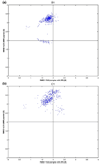Antigenic characteristics of rhinovirus chimeras designed in silico for enhanced presentation of HIV-1 gp41 epitopes [corrected]
- PMID: 20138057
- PMCID: PMC2940250
- DOI: 10.1016/j.jmb.2010.01.064
Antigenic characteristics of rhinovirus chimeras designed in silico for enhanced presentation of HIV-1 gp41 epitopes [corrected]
Erratum in
- J Mol Biol. 2010 May 14;398(4):623-4
Abstract
The development of an effective AIDS vaccine remains the most promising long-term strategy to combat human immunodeficiency virus (HIV)/AIDS. Here, we report favorable antigenic characteristics of vaccine candidates isolated from a combinatorial library of human rhinoviruses displaying the ELDKWA epitope of the gp41 glycoprotein of HIV-1. The design principles of this library emerged from the application of molecular modeling calculations in conjunction with our knowledge of previously obtained ELDKWA-displaying chimeras, including knowledge of a chimera with one of the best 2F5-binding characteristics obtained to date. The molecular modeling calculations identified the energetic and structural factors affecting the ability of the epitope to assume conformations capable of fitting into the complementarity determining region of the ELDKWA-binding, broadly neutralizing human mAb 2F5. Individual viruses were isolated from the library following competitive immunoselection and were tested using ELISA and fluorescence quenching experiments. Dissociation constants obtained using both techniques revealed that some of the newly isolated chimeras bind 2F5 with greater affinity than previously identified chimeric rhinoviruses. Molecular dynamics simulations of two of these same chimeras confirmed that their HIV inserts were partially preorganized for binding, which is largely responsible for their corresponding gains in binding affinity. The study illustrates the utility of combining structure-based experiments with computational modeling approaches for improving the odds of selecting vaccine component designs with preferred antigenic characteristics. The results obtained also confirm the flexibility of HRV as a presentation vehicle for HIV epitopes and the potential of this platform for the development of vaccine components against AIDS.
Copyright 2010 Elsevier Ltd. All rights reserved.
Figures







Similar articles
-
Chimeric rhinoviruses displaying MPER epitopes elicit anti-HIV neutralizing responses.PLoS One. 2013 Sep 6;8(9):e72205. doi: 10.1371/journal.pone.0072205. eCollection 2013. PLoS One. 2013. PMID: 24039745 Free PMC article.
-
In silico vaccine design based on molecular simulations of rhinovirus chimeras presenting HIV-1 gp41 epitopes.J Mol Biol. 2009 Jan 16;385(2):675-91. doi: 10.1016/j.jmb.2008.10.089. Epub 2008 Nov 8. J Mol Biol. 2009. PMID: 19026659 Free PMC article.
-
Broad neutralization of human immunodeficiency virus type 1 (HIV-1) elicited from human rhinoviruses that display the HIV-1 gp41 ELDKWA epitope.J Virol. 2009 May;83(10):5087-100. doi: 10.1128/JVI.00184-09. Epub 2009 Mar 11. J Virol. 2009. PMID: 19279101 Free PMC article.
-
Progress towards the development of a HIV-1 gp41-directed vaccine.Curr HIV Res. 2004 Apr;2(2):193-204. doi: 10.2174/1570162043484933. Curr HIV Res. 2004. PMID: 15078183 Review.
-
The membrane-proximal external region of the human immunodeficiency virus type 1 envelope: dominant site of antibody neutralization and target for vaccine design.Microbiol Mol Biol Rev. 2008 Mar;72(1):54-84, table of contents. doi: 10.1128/MMBR.00020-07. Microbiol Mol Biol Rev. 2008. PMID: 18322034 Free PMC article. Review.
Cited by
-
Advances in all atom sampling methods for modeling protein-ligand binding affinities.Curr Opin Struct Biol. 2011 Apr;21(2):161-6. doi: 10.1016/j.sbi.2011.01.010. Epub 2011 Feb 19. Curr Opin Struct Biol. 2011. PMID: 21339062 Free PMC article. Review.
-
Conformational Transitions and Convergence of Absolute Binding Free Energy Calculations.J Chem Theory Comput. 2012 Jan 10;8(1):47-60. doi: 10.1021/ct200684b. J Chem Theory Comput. 2012. PMID: 22368530 Free PMC article.
-
HIV-1 Gag p17 presented as virus-like particles on the E2 scaffold from Geobacillus stearothermophilus induces sustained humoral and cellular immune responses in the absence of IFNγ production by CD4+ T cells.Virology. 2010 Nov 25;407(2):296-305. doi: 10.1016/j.virol.2010.08.026. Epub 2010 Sep 20. Virology. 2010. PMID: 20850858 Free PMC article.
-
Chimeric rhinoviruses displaying MPER epitopes elicit anti-HIV neutralizing responses.PLoS One. 2013 Sep 6;8(9):e72205. doi: 10.1371/journal.pone.0072205. eCollection 2013. PLoS One. 2013. PMID: 24039745 Free PMC article.
-
Role of Ligand Reorganization and Conformational Restraints on the Binding Free Energies of DAPY Non-Nucleoside Inhibitors to HIV Reverse Transcriptase.Comput Mol Biosci. 2012 Mar;2(1):7-22. doi: 10.4236/cmb.2012.21002. Comput Mol Biosci. 2012. PMID: 22708073 Free PMC article.
References
-
- Karlsson Hedestam GB, Fouchier RA, Phogat S, Burton DR, Sodroski J, Wyatt RT. The challenges of eliciting neutralizing antibodies to HIV-1 and to influenza virus. Nat. Rev. Microbiol. 2008;6:143–155. - PubMed
-
- Alfsen A, Bomsel M. HIV-1 gp41 envelope residues 650–685 exposed on native virus act as a lectin to bind epithelial cell galactosyl ceramide. J. Biol. Chem. 2002;277:25649–25659. - PubMed
-
- Zwick MB, Jensen R, Church S, Wang M, Stiegler G, Kunert R, et al. Anti-human immunodeficiency virus type 1 (HIV-1) antibodies 2F5 and 4E10 require surprisingly few crucial residues in the membrane-proximal external region of glycoprotein gp41 to neutralize HIV-1. J. Virol. 2005;79:1252–1261. - PMC - PubMed
Publication types
MeSH terms
Substances
Grants and funding
LinkOut - more resources
Full Text Sources

